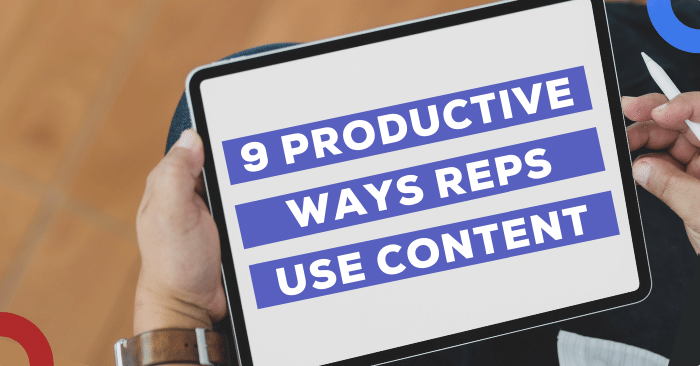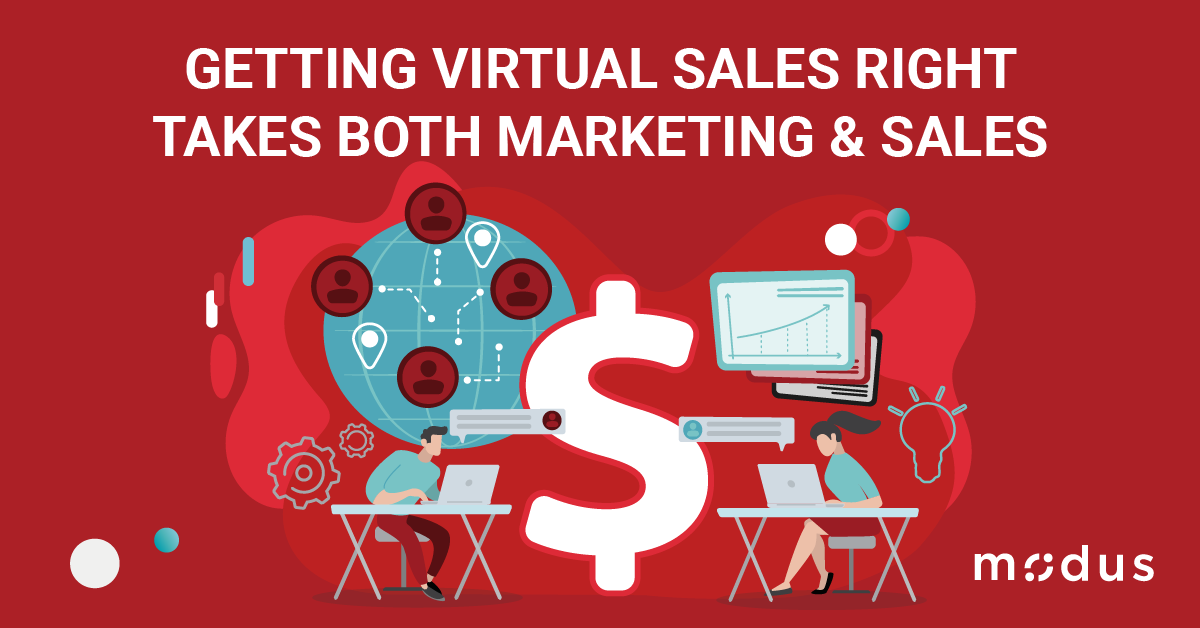Busy buyers don't have time to read content inapplicable to solving their specific business problems. In today's business world, customers face dramatically difficult considerations and a disconnect in the current sales model, which doesn't offer them confidence in making the best business decisions. According to Gartner for Sales,
B2B buying is hard. Unaddressed, customers' struggle to buy means suppliers failing to provide help (in the form of what we've come to call "Buyer Enablement") is unlikely to win large deals predictably or consistently."
But there's good news: sales reps that deliver value using digital content to engage customers in rich discovery and self-learning will gain access to buyer conversations and, in turn, offer customers this needed confidence. Engaging content leads to a connection with the business, which leads to trust in the seller's brand. By establishing trust, the prospect can become a client, and the rep can deliver ROI.
Below are 9 distinct ways sellers can use content for buyer enablement:
1. To Build Credibility
Using content to become an expert on your solution and confidently presenting your product amongst the rest is key to becoming a credible and trusted advisor. Entrepreneur says,
Put yourself in the prospect's shoes -- who are you more likely to buy from? A rep who saves their pitch for the phone, or a rep who lives, breathes, and believes in their product, day in and day out? You need to show prospects that you care more than anyone else."
Showing buyers how your solution works to alleviate their pain point says you've invested time and energy in understanding their business needs. Leveraging similar case studies helps prove why and how your product works and further builds your credibility.
2. To Help Debunk a Myth that Buyers May Believe
Given that many departments are involved in each B2B sale, they often don't 1) agree on the business problem and 2) don't consent on the way to solve it. By working with multiple stakeholders inside the business and intently listening and garnering information, the rep can share insights and use targeted content to connect overall organizational goals.
This leads to an HQD (high-quality deal) where customers feel they are achieving the value they expected. Gartner finds an average of 11 people involved in B2B purchases. Deciding on the problem, deconflicting information, and getting everyone on board is one of the biggest challenges buying committees face. Sales reps who can help decision-makers reframe their problem and approach to solving it will find more avenues to sales growth. Delivering the right content relevant for each stakeholder debunks the myth that buyers cannot find the right solution.
3. To Become a Trusted, Reliable Resource
Studies show that 71% of buyers wait to engage a salesperson until they’ve identified their perceived needs. Their waiting makes it more critical than ever to be that trusted resource upon whom your customer depends. Through consistent communication and sharing of industry information, use cases that resemble how product X would perform in their environment, and other thoughtful, personalized content elevates reps to SMEs. An article by Eric Schwartzman notes that:
When buyers meet sales professionals who can discuss the macro issues facing their industry, instead of the features and benefits of their product, they are instantly elevated to trusted advisor status.”
This trusted status gets reps in the door time and time again and rewards them with repeat business that leads to sales growth.
4. To Help a Buyer Talk to Another Stakeholder on the Buying Committee—or Understand the Perspective of Another
Not all stakeholders understand the value of the solution to the organization. Each person on the buying committee comes to the table with their lens, and often, the buying teams are their own source of tension. Reps must gather insights from all parties involved, share the information, and direct team members to a solution that meets the needs of each stakeholder to create consensus amongst them. The content must appeal to the enterprise overall, rather than individual team members. According to Gartner:
Increasing common ground decreases the likelihood of defaulting to the lowest common denominator.”
Targeting the enterprise persona and identifying content assets that meet the organizational strategic goals leads to successful buy-in.
5. To Collaborate with Buyers to Co-Create the Solution (Solution Selling)
Once the rep is in the door with a buyer, collaborating to build the solution that meets his business objectives is critical. And agents need to play the role of helping validate the decision. Interactive content that both the buyer and seller work on together, like ROI calculators and value assessments, are necessities to achieve the client’s needs of avoiding risk and hopefully garnering praise from within the organization. Keith M. Eades, author of The New Solution Selling, shares a concise definition of solution selling:
Not only does the problem need to be acknowledged by the buyer, but both the buyer and salesperson must also agree on the answer. So, a solution is a mutually agreed-upon answer to a recognized problem. Also, a solution must provide some measurable improvement. Buy measurable improvement, I mean there is a before and an after. Now we have a complete definition of a solution; It’s a mutually shared answer to a recognized problem, and the answer provides measurable improvement.”
Reps using the tools and content available to them that positively impact stakeholder metrics help get a sale across the line.
6. To Answer Buyers' Questions at Every Stage of the Buying Process
In a complex and challenging buying journey, buyers require answers and direction throughout the process. Reps can serve as a valuable resource to softly nudge buyers along throughout the cycle by using content that answers questions, including:
- Will my team use it?
- Does it fit with our existing architecture?
- Is it easily adaptable?
- Will we achieve the outcome we need?
- Does this provider expose us to risk?
These questions, and more, need to be addressed throughout the sales process. Using case studies, demos, sharing onboarding processes, and other valuable content leads to the buyer's ability to complete the jobs to be done in buying and gain peace of mind.
7. To Help Buyers Build Confidence They are Making the Right Choice
Gaining the customer's confidence in a solution is key to a successful outcome. And buyer enablement, defined as "giving prospects what they need to make good decisions – ideally, without feeling pressured or unduly influenced," is a great way to get one. By framing oneself as a specialist and using FAQs, customer testimonials, use cases, and content tailored to the various stages of the buyer journey, a buyer can choose a rep with confidence. Being authentic and putting oneself into the buyer's mindset to make them shine in their organization promotes confident buying decisions.
8. To Gain Access to Buyer Conversations
Buyers do much research before reaching out to a rep, and reliable content can move the needle toward a specific company. as Assets including presentations, whitepapers, social media shares, blog posts, and newsletters are useful tools for gaining access to a new buyer. Alignment to the buyer's persona and use case at each stage in the journey gives sellers a better chance to engage a buyer at the right time with information that’s timely and useful.
9. To Help Buyers Create Momentum to Move Forward With Purchasing
At the bottom of the sales funnel, content connects the dots between a customer's pain and a solution the seller can offer. Content like customer reviews and repurposed case studies that are more specific and tailored help guide buyers toward a purchase decision. LeadCrunch says customer reviews play a big role in building customer trust that sways buying decisions:
Customer reviews also play into the ’influencer‘ buying behavior; if your product is well endorsed, you have a significant advantage. 93% of consumers report they look to customer reviews to guide their buying decisions, making your current customers one of your company's most valuable marketing assets."
Wise Use of Content Gives Your Reps Credence with Buyers.
Buyer enablement includes presenting an honest picture of what your solution brings to the table – what sets your answer apart from the rest. It means helping buyers visualize what it looks like inside the customer's organization, and how it immediately adds value by solving a business challenge. Buyer enablement is a momentum builder that helps buyers to make sense of their choices and justify and reach a buying decision.
With so much self-education conducted during the buying process, reps effective use of content to move buyers toward solving their primary business problem and understand why they should take a specific route to do so can help them get more sales done. Forrester says:
Tomorrow's buyers will expect every experience with your organization – all the content they access, all the conversations they have, and all the offers they receive – to feel like a natural and logical extension of their previous experiences.”
Thus, the sales reps who share content buyers consider relevant and personalized and offer uncommon insights they can't find independently, will gain more purchase decisions in their favor.



